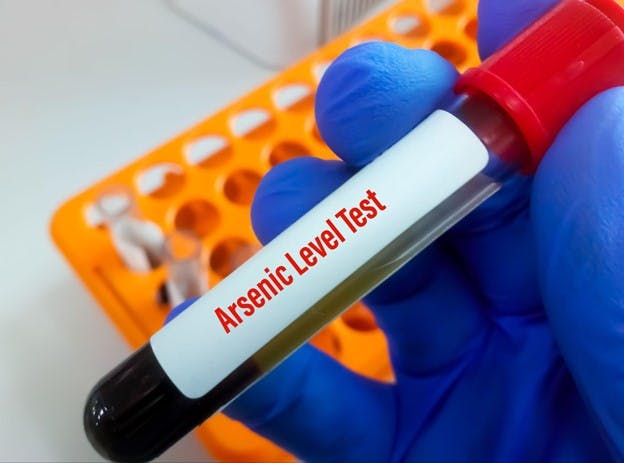🌟 New Arrival! Upgrade Your Water with Our Advanced Pitcher Filter. Shop Now
February 2024
Arsenicosis: The Hidden Dangers of Arsenic Toxicity
Arsenic poisoning doesn’t just happen to characters in murder mysteries. Arsenicosis, the scientific term for a health condition arising from chronic arsenic exposure, is a rare but potentially fatal condition that occurs when a person ingests too much arsenic. This can occur through exposure to natural sources of arsenic, ingesting contaminated foods, and even drinking tap water.
Here’s what you need to know about arsenicosis — including its causes, its symptoms, and how you can reduce the risk of arsenic exposure with filtered drinking water.
What Is Arsenicosis and What Causes It?
Arsenicosis, or arsenic poisoning, refers to toxicity caused by the buildup of arsenic in the body over time. Arsenic can be ingested, inhaled, and absorbed through the skin, and chronic arsenic exposure can lead to serious health effects and even death.
Arsenic is a naturally occurring substance — element 33 on the periodic table, with the abbreviation “As.” According to the National Institute of Environmental Health Sciences, “Arsenic levels in the environment can vary by locality, and it is found in water, air, and soil,” including in wells and other groundwater sources.
Arsenic is a semi-metallic substance, and is odorless and tasteless, which is why it’s important to recognize the signs of arsenicosis and test for arsenic levels in drinking water. Like lead and mercury, arsenic is lethal in large amounts, but even low levels can lead to chronic arsenic poisoning over time.

What Are Some Common Sources of Arsenic Exposure?
Arsenic exposure is more common than you might think. The U.S. Centers for Disease Control (CDC.gov) reports that the “average daily dietary intake of arsenic by adults in the United States is 40 micrograms per day.” Where does it all come from? Here are four of the most common sources.
Rice and Grains
Depending on where it’s grown, rice can be a leading source of arsenic exposure in the diet — and this includes cereals and other processed foods made with rice. Rice absorbs arsenic from water, soil, and herbicides, and rice that’s grown in the U.S., China, India, and other parts of the world can all have dangerously high levels of arsenic.
There are steps you can take to remove some of the arsenic in rice, such as rinsing rice before you cook it and boiling it in large quantities of water. You can also choose white rice instead of brown rice, although this has lower nutritional value. For most healthy adults, simply eating a varied diet can limit chronic arsenic toxicity via rice.
The U.S. Food and Drug Administration (FDA) has also released guidelines to limit the level of arsenic in infant rice cereal, while the Food and Agriculture Organization of the U.N. and the World Health Organization (WHO) have released a Code of Practice for the Prevention and Reduction of Arsenic Contamination in Rice.
Meat and Seafood
Meat and seafood products can also contain high concentrations of arsenic. The good news is that the arsenic found in fish is mostly organic arsenic, which is “almost always harmless,” according to Dartmouth College, but some types of shellfish and seaweed can contain high levels of inorganic arsenic, which is harmful to humans.
The best mitigation strategy is to avoid Hijiki seaweed and follow any shellfish eating guidelines or advisories from the Environmental Protection Agency (EPA).
Poultry has historically been a source of arsenic exposure, due to arsenic compounds found in chicken feed, but these drugs are no longer allowed by the FDA.
Drinking Water
Another potential source of arsenicosis is the ingestion of arsenic-contaminated water. Arsenic may be found in groundwater, where natural deposits can infiltrate wells and aquifers, and less commonly in surface water, such as rivers and streams.
The incidence of arsenic in groundwater can be much higher in areas where mining, fracking, pesticide use, and other industries contaminated the water supply.
In the U.S., inorganic arsenic levels in drinking water must be below 10 parts per billion (ppb), but this doesn’t apply to private wells, which may have higher levels of arsenic. Some organizations, such as the Environmental Working Group (EWG), recommend even stricter limits of no more than 0.004 ppb, or 4 parts per trillion.
Environmental Exposure
Arsenic can also be ingested through the skin and through the airways, although this type of exposure is less common. People who work in smelting facilities, or factories that produce glass or pesticides, are most at risk for long-term exposure.
Tobacco smoke also contains traces of arsenic, as well as smoke from burning fossil fuels and wood that’s been treated with arsenic.

What Are the Symptoms and Health Effects of Arsenicosis?
The signs of acute arsenic poisoning differ from the symptoms of chronic arsenicosis. The following symptoms can appear within minutes or hours of acute exposure:
- Abdominal pain
- Chest pain
- Coughing
- Diarrhea
- Nausea
- Vomiting
- Low blood pressure
- Peripheral neuropathy
- Abnormal heart rhythm
At lower levels of exposure, the symptoms of arsenicosis can take years to develop. Some of the most common signs of arsenicosis include:
- Hyperkeratosis, or rough patches of skin that can be a precursor to squamous cell carcinoma, a type of skin cancer
- Darkening of the skin or abnormal skin pigmentation
- Mees’ lines, or white bands on the fingernails
- Recurring sore throat or digestive problems
- Warts and skin lesions
Chronic arsenic exposure can also have other side effects on human health. Arsenic is a carcinogen, and both its organic and inorganic forms can cause liver, kidney, bladder, lung, and other cancers. It can also contribute to hypertension (high blood pressure), and peripheral vascular disease, or reduced blood flow to the limbs.
How Is Arsenicosis Diagnosed and Treated?
Arsenicosis can be diagnosed using several different tests, including blood tests, urine tests, and hair and fingernail clippings. Urine is used to detect recent exposure, while hair and fingernails can show chronic arsenic exposure over the long-term.
Home testing kits are available but may be less useful than a professional diagnosis. Biomarkers like urine and fingernails can indicate high levels of exposure, but don’t necessarily identify specific health concerns arising from arsenicosis.
When detected early, the prognosis for arsenicosis is good. The main treatment for arsenicosis is to limit additional arsenic exposure so that arsenic levels in the body return to a safe level. For acute arsenic poisoning, treatment may include:
- Chelation therapy to remove arsenic from the blood
- Bowel irrigation to reduce the absorption of arsenic
- Vitamin E and selenium therapy
Even in the absence of symptoms, people whose biomarkers indicate high levels of arsenic should make lifestyle changes to reduce further intake of arsenic.
Which Parts of the World Is Arsenicosis Most Common?
Arsenicosis is a greater risk in some parts of the world than others. Some countries with high levels of arsenic contamination in the groundwater include:
- The United States
- India
- China
- Mexico
- Chile
- Bangladesh
Even within countries, arsenic levels in the groundwater aren’t evenly distributed. In the U.S., wells in the Southwest, Midwest, and Northeast have higher levels of arsenic than wells in the Southeast, with as many as 2.1 million Americans affected.
Globally, parts of Bangladesh and the Indian state of West Bengal are most at risk, with more than 100 million people affected by arsenic contamination in tube wells.

What Steps Can You Take to Reduce Arsenic Exposure?
The best way to mitigate the risk of arsenicosis depends on the source of exposure. If you work in an environment that may contain arsenic, be sure to wash your hair, skin, and clothing thoroughly, and use a face mask to prevent inhalation.
If you’re concerned about long-term exposure from drinking water, you can:
Test Your Tap Water for Arsenic and Other Contaminants
In addition to arsenic, drinking water can contain unsafe levels of other chemicals and contaminants. Some contaminants are found in the groundwater, while others are a byproduct of the disinfection process, such as chromium and trihalomethanes.
You can test your tap water for arsenic yourself using an at-home kit or send a water sample to a certified lab for more accurate results. You can also use a meter to check for total dissolved solids (TDS). High levels of total dissolved solids can be a sign of arsenic, lead, or other contaminants that call for further investigation.
Install a Home Water Filter or Arsenic Removal System
Home water filters can reduce or eliminate common contaminants from your drinking water, including arsenic. Activated carbon filters, reverse osmosis filters, and other filtration systems all remove arsenic to various degrees.
Boiling tap water or using a water softener won’t remove arsenic, so choose a home water filter or arsenic removal system that can do the job.
Remember, by law, your arsenic levels should be no more than 10 ppb, but you may prefer to follow the more cautious recommendations of the EWG.
Be Cautious When Using Groundwater and Rainwater
Whether or not your groundwater contains arsenic will depend on where you live and how deep your well is. Shallow wells are more likely to be contaminated than deep wells, and even rainwater can accumulate arsenic from the environment.
Get familiar with your local water quality issues, and be sure to test your well water yourself, since drinking wells aren’t bound by the same EPA guidelines.

Protect Yourself with a Home Water Filter
Arsenicosis is the scientific term for arsenic poisoning, which is what happens when the body accumulates high levels of arsenic. Arsenicosis can lead to serious health effects, including certain cancers, but can be avoided by reducing your exposure to arsenic in your food, drinking water, and environment.
Most people aren’t at high risk of arsenic toxicity, but some parts of the U.S. have higher levels of contamination than others. Test your tap water and install a home water filter like the HomeWater EZChange 2-Stage Under Counter Under Sink Water Filter to reduce your exposure to chlorine, lead, arsenic, and other common contaminants.